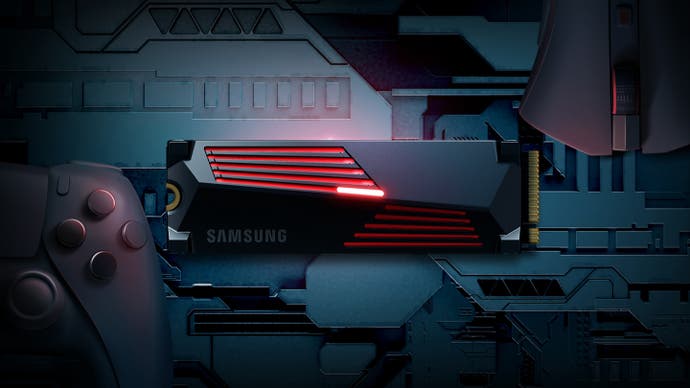Best SSD for gaming 2023: shorter loading times, smoother streaming
Our top picks, plus what you need to know about different SSDs.
You may have noticed that SSD prices have dropped like a stone recently, with the debut of the first PCIe 5.0 drives making PCIe 3.0 and 4.0 NVMe drives ever cheaper. SATA SSDs are hitting new low prices too, with even high-capacity options costing surprisingly little. That makes it a great time to pick up a new larger and/or faster model, which provides more storage space and cutting load times significantly.
In this article, we've rounded up the best SSDs for the money right now, based on our extensive testing. Whether you're looking for a cheap, high-capacity budget drive for media storage or a blazing-fast option for minimising game load times, we've got a recommendation or two for you here.
Let's get right into it. You can jump straight to the selection you're interested in using the links below - including our brief explainers at the bottom of the article - or scroll on!
- Best cheap NVMe SSD
- Best NVMe SSD for the money
- Best NVMe SSD for mixed workloads
- Best cheap PCIe 4.0 SSD
- Fastest PCIe 4.0 SSD
- Best RGB NVMe SSD
- Best value SATA SSD
- Fastest SATA SSD
- Best portable SSD
- Best cheap portable SSD
- Best SSD for PS5
More information
Best cheap NVMe SSD: WD Blue SN570

The WD Blue SN570 is our new best budget SSD pick, replacing the older WD Blue SN550. The new model costs slightly more, but offers significantly faster sequential speeds, moving from 2400MB/s reads to 3500MB/s reads - a pretty tasty improvement. Write speeds are up too, from 1950MB/s to 3000MB/s, but be aware that the smaller drives have correspondingly lower write speeds (a common SSD phenomenon). Note that the SN570 uses TLC memory rather than cheaper QLC, which allows WD to offer a five year warranty - nice. With about a £10 cost premium over the outgoing SN550 (at time of writing), the SN570 is the best value option, although I wouldn't rule out the SN550 if it's been steeply discounted, or if you want a 2TB size - right now, the SN570 tops out at 1TB.
Overall recommendations? Well, this DRAM-less SSD doesn't measure up to the fastest PCIe 3.0 drives on the market, particularly in sustained random writes, so it's an ideal choice for storing games or media, but a little less good as an OS drive or for heavy tasks like video editing. Here, higher-grade SSDs with DRAM caches perform better. Meanwhile, Samsung's 980 can sometimes be discounted below the SN570 while offering faster real-world performance, so check both models' prices. Ultimately though, the SN570 is a great budget choice.
Best NVMe SSD for the money: Adata XPG SX8200 Pro
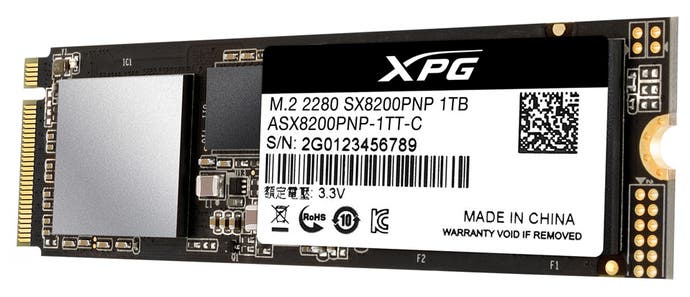
The XPG SX8200 Pro is a cut-price NVMe drive offers similar real-world performance to the Samsung 970 Evo Plus at a dramatically lower price. In our testing, the SX8200 Pro delivered class-leading random read performance, while still offering strong sequential results. Game load times were also impressive, with some of the best results we've seen outside of the (incredibly expensive) Intel Optane 905P. The drive is also very power-efficient, making it a good candidate for use in laptops. All in all, this is the best NVMe drive on the market for the money.
Best NVMe SSD for mixed workloads: WD Black SN750
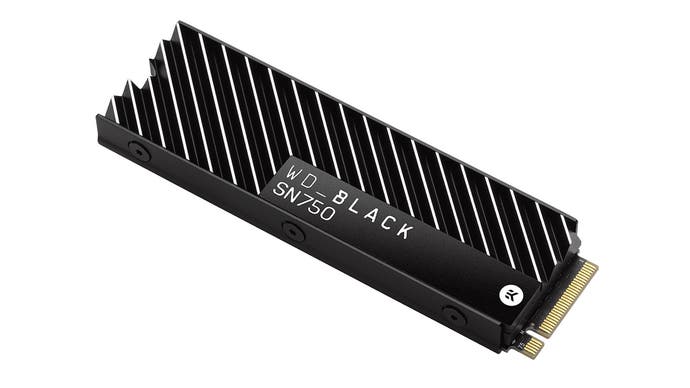
The WD Black SN750 is a great choice for mixed workloads, eg computers that are used for both gaming and content creation tasks like video editing. The drive turns in strong sequential performance and offers good power efficiency, although it comes up a bit short in random read and write tasks compared to its main rival, the Samsung 970 Evo. The SN750 is currently the cheaper drive by a significant margin, so it has become the better choice for most people. You can also get a model with a heatsink attached for a small premium, which may come in handy for M.2 mounts in laptops, on the back side of your motherboard or other cramped locations with little airflow. This helps the drive maintain a high level of performance, making it a canny choice.
A SN750 SE drive is also now available, which offers slightly faster speeds (3600MB/s reads) and uses PCIe 4.0 instead of 3.0, allowing it to use fewer PCIe lanes and be more power-efficient. It remains more expensive than the vanilla SN750 for now (£140/$131 at time of writing), but it's worth knowing about for use in laptops.
Best cheap PCIe 4.0 SSD: Sabrent Rocket NVMe 4.0
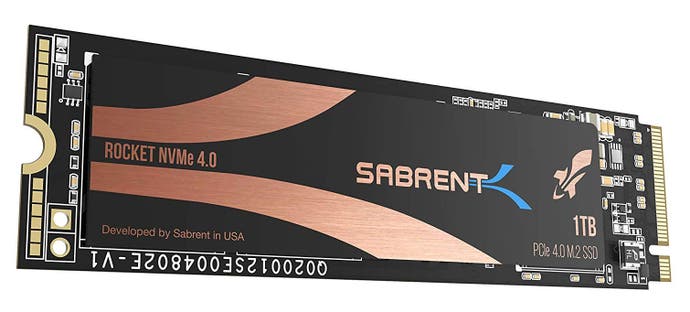
The Sabrent Rocket NVMe 4.0 is one of the most affordable PCIe 4.0 drives on the market, with a 1TB model costing less than competing drives like the Corsair MP600 and Gigabyte Aorus PCIe 4.0. Despite being cheaper and of a lesser-known brand, the Rocket drive offers essentially the same performance - thanks to its use of the same Phison controller and 96-layer TLC NAND as the other 'first-gen' PCIe 4.0 options. Note that game load times aren't significantly better with PCIe 4.0, but you'll notice better performance in more intensive content creation tasks that can utilise the 3400MB/s reads and 3000MB/s writes. Second-gen PCIe 4.0 drives (below) hit even higher sequential speeds, up to 7000MB/s reads and 5300MB/s writes.
Fastest PCIe 4.0 SSD: Samsung 990 Pro

If you've got the need for (storage) speed, the £155/$170 Samsung 990 Pro is an excellent option and the fastest consumer drive we've ever tested. The 990 Pro offers the highest sequential read and write speeds on the market, thanks to its use of high-speed TLC NAND, a top controller and the next-gen PCIe 4.0 interface. Its random speeds are impressive too, at up to 1400K / 1550K IOPS for reads and writes respectively - that's 1.5x as fast as our previous 'fastest SSD', the WD SN850. This unlocks simply incredible loading times, and this differential should increase further as and when DirectStorage enabled games hit the market.
There's also a version which comes with a heatsink for a small premium, but we couldn't find it for sale online at the time of writing. This add-on helps maintain peak performance and prevent thermal throttling, especially in cramped cases with minimal natural airflow. It also ensures the drive meets the requirements for use in the PS5, although you could also add a third-party heatsink without much bother.
Best RGB NVMe SSD: XPG Spectrix S40G
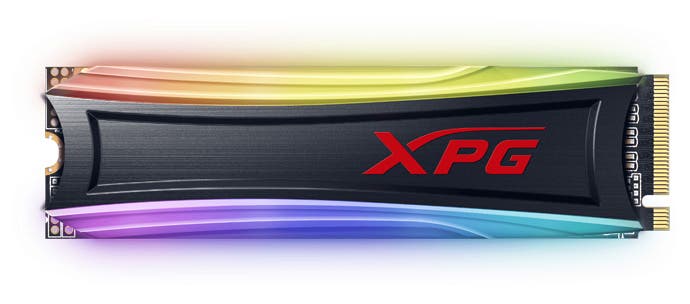
RGB has become a major trend in PC components and peripherals, and SSDs are no exception. Early RGB SSDs had a tendency to overheat, but that issue seems to have been improved in more recent examples. The fastest we've tested is the XPG Spectrix S40G, which approaches the sequential speeds of its flagship SX8200 Pro NVMe drive recommended above. However, it does show some temperature-related throttling during during sustained loads, suggesting that those hungry for the best possible performance should skip RGB for the meantime. If you do opt for an RGB SSD, then we suggest mounting it in a position to benefit from airflow from nearby case fans while avoiding the hot exhaust from graphics cards.
Best value SATA SSD: Crucial MX500
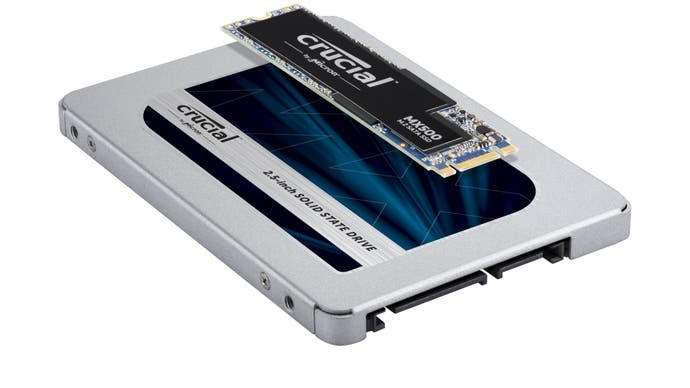
The Crucial MX500 is one of the best options on the market, offering excellent performance for a SATA drive at a consistently reasonable price. While the firm's BX500-series drives are even cheaper, the MX500 sports better random read and write performance and a higher endurance rating that justifies the small extra investment. It's also available in two form factors: compact, cable-less M.2 or standard 2.5-inch. You can even combine the MX500 with a SATA to USB cable or enclosure to use as external storage for game consoles, including the Xbox Series X/S, PS5, Xbox One or PS4.
Fastest SATA SSD: Samsung 870 Evo
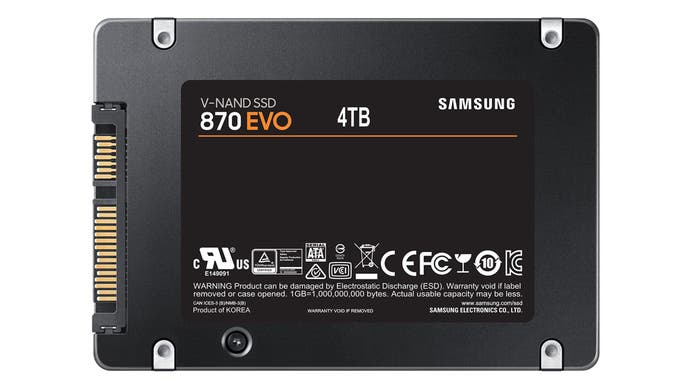
The Samsung 870 Evo is a TLC (3-bit NAND) alternative to the company's QLC (4-bit NAND) 870 Qvo drive. By storing fewer bits per cell compared to the earlier Qvo drive, cost per gigabyte increases but performance is also improved. This is particularly true for random performance, where small pieces of data are being read or written rather than long, sequential chunks - think gaming rather than copying a large video file, for example. Write endurance is also increased, as demonstrated by the 870 Qvo's three year warranty compared to the five-year warranty offered by Samsung for the 870 Evo.
In our testing, the 870 was the fastest SATA drive we've ever tested, beating out the Crucial MX500 and Samsung's own 860 Evo. For that reason, the 870 Evo is a great choice if you need top-tier performance and you don't have the luxury of a higher-speed NVMe slot.
Best portable SSD: Crucial X8
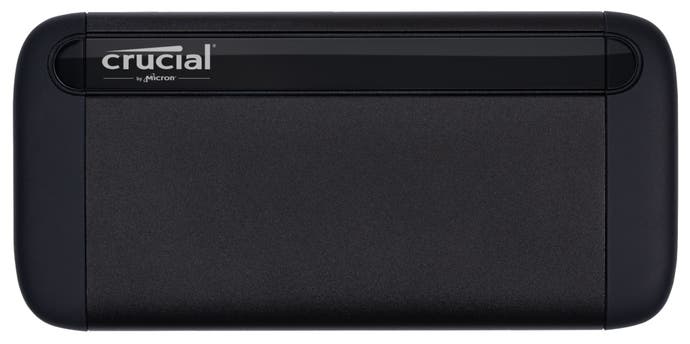
Crucial's X8 SSD is the best portable option we've tested, thanks to its compact frame and extremely high speeds. Essentially an NVMe drive tucked into a compact and bespoke enclosure, the X8 delivered sequential reads of 933MB/s and sequential writes of 878MB/s in our testing of the 1TB model; random I/O performance was also strong. That makes it convenient to ferry around the house or the office, while also ensuring that games load quickly and files copy over in a flash.
The short cable in the box works with both USB-C and full-size USB-A ports, so ensure you're connecting to your system's fastest USB port (ideally a USB 3.2 Gen 2 USB-C port) to unlock the drive's full potential. As well as working on PCs and Macs, the drive can also be used for game storage on Xbox Series X/S, Xbox One, PS4 and PS5. (Note that the default firmware on some models may not play well with the PS5, so you can follow instructions here to upgrade the firmware and solve the issue.)
Best external SSD for PS5 and PS4 - and more durable
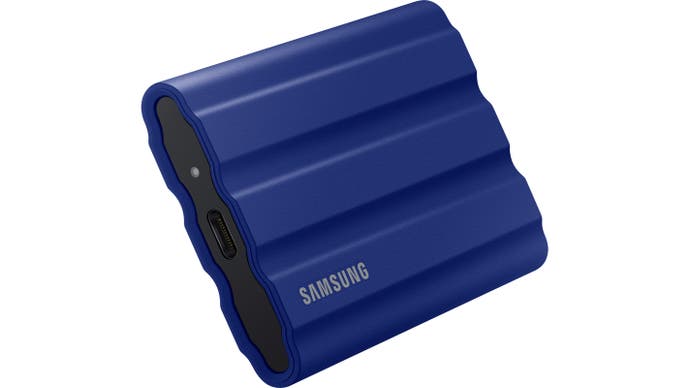
A good alternative to the Crucial X8 that works perfectly with PS5 and PS4 is the $135/£135 Samsung T7 Shield. This drive is around 20 per cent smaller than the X8 and has a durable soft touch enclosure which should prevent the drive from becoming damaged even with careless use. Its overall sequential and random speeds are extremely similar to the X8, maxing out around 913MB/s in sequential reads and 890MB/s for writes. However, wider compatibility makes this a great choice for anyone planning to use the drive with PlayStation hardware.
Common terms
SATA: This legacy interface was initially designed to allow relatively low-bandwidth drives, such as CD-ROM drives and mechanical HDDs, to connect to your computer. As SSDs improved in speed over time, they started to run up against the limits of the SATA III interface - specifically, maximum sequential read and write speeds of around 550~600MB/s. This bottleneck prompted the creation of a new interface, NVMe.
NVMe: This modern interface is designed specifically for high-speed solid state drives, relying on the PCIe standard that is also used for graphics cards, network cards and other add-in cards. The greater bandwidth available removes the interface bottleneck, thereby allowing high-end SSDs to reach increasingly higher speeds and lower access times.
2.5-inch: This form factor is probably what you'd picture if you imagined an SSD: a simple metal cuboid, 70 x 100 millimetres in size with separate data and power cables. The vast majority of 2.5-inch drives can only connect via the relatively slow SATA interface.
M.2: This very flat form factor boasts a much smaller volume than a standard 2.5-inch SSD, allowing these drives to be mounted directly onto a desktop computer's motherboard or inside a slim laptop. Confusingly, M.2 drives can be either (slow) SATA or (fast) NVMe types, so make sure you know which kind of drive you're buying. While most motherboard M.2 slots will support both options, allowing fast NVMe M.2 drives to be connected, some are SATA-only, so once again be sure to check which your computer supports before purchasing. M.2's single connector includes both data and power, and as you're plugging directly into the motherboard you won't need to run any cables.
PCIe: If you have a spare PCIe x4 or x16 slot on your motherboard, then you can connect an NVMe SSD here. You can either use an M.2 NVMe drive together with a PCIe adaptor card, or you can directly connect a PCIe NVMe add-in card.
Reads vs writes: Reads refer to data is being taken from storage to the processor so it can be used; writes are the opposite, where data is being sent from the processor to storage to be accessed later. Reading data is more common than writing data, so often read speeds will be higher than write speeds.
Sequential vs random: This refers to whether the data you're reading or writing is grouped together in a row or spread out across the drive. For example, a sequential read might be loading a single video file into memory, while a random read might be accessing multiple files to load a game. This is only a simplification, and most games use both sequential and random reads to load. Generally, sequential data is easier to read and write quickly than random data.
Frequently asked questions
Which type of SSD is best for me - NVMe or SATA?
To answer this question, you need to identify what you'll be using the drive for - either playing games and normal day-to-day tasks like web browsing, or more intensive operations like editing 4K video or crunching through large scientific or engineering datasets.
For computers that are primarily used for playing games, our research suggests that you'll only see minimal improvements to game load times by swapping a standard SATA-connected SSD for a more expensive NVMe drive, even if it boasts significantly higher read and write speeds. Unless the rest of your system is already top notch, you will probably notice a bigger performance difference from upgrading to one of the best graphics cards rather than shelling out for a super-fast NVMe drive that sits at the top of the benchmark charts.
Therefore, we recommend you take a look at our recommendations for the best value-for-money SSDs on the market, including drives from some lesser-known brands. These drives largely use SATA connections, preventing their performance from surpassing a certain threshold, but they do offer the biggest capacities for the lowest prices. All modern motherboards support SATA too, so you won't have to worry about compatibility.
Of course, there's also an argument to be made for going for faster NVMe drives. Specifically, gamers that don't want to upgrade their storage for a long time or creative professionals that require utmost performance may want to spend more to really maximise their performance. Just remember that not all motherboards support these fast NVMe drives out of the box; you'll either need an M.2 slot that supports NVMe, or a free PCIe slot.
What size SSD do I need?
Thanks to recent drops in flash memory prices, solid state drives have become increasingly affordable - even though they're still far pricier per gigabyte than mechanical hard disk drives. As with most things, there is a tradeoff when deciding how big of a drive to choose. The smaller the drive, the more careful you'll have to be with the space that you've got - such as by uninstalling games you're not playing and moving media and downloads to a mechanical HDD. This kind of curation can be a pain, so saving up for a bigger drive makes sense. Larger drives are also slightly faster, particularly in terms of write speeds, than their smaller-capacity counterparts. Finally, choosing a larger drive will mean that it will last you a longer time. As games include higher-resolution textures and videos, they will continue to balloon in size, so having some breathing room will let you put off a drive upgrade for at least a few years.
So what about specific capacities? At the time of writing, a 250GB drive is probably a good starting point for most people, giving you enough room to install Windows and a few large games with space to spare for Windows updates, HD downloads and so on. If you like to keep more than a dozen games installed at once or you have a media collection that you don't want to keep on a second drive, then choosing a 500GB or 1TB drive makes more sense. Right now these 500GB and 1TB drives are in the price-per-gig sweet spot, so spring for them if you can. 2TB SSDs are starting to become reasonable in price too, and if you stick with SATA speeds, you can pick up a gargantuan amount of solid state storage for a few hundred dollars.
Can I install an SSD into my PS4 or Xbox One to improve its loading speeds?
Yes! On the PS4 and PS4 Pro, you can replace the system's internal drive with an SSD, while the Xbox One and PS4 Pro can have an external SSD connected over USB 3.0. You can see our investigations into game load time improvements with the PS4, PS4 Pro and Xbox One here.
For an internal upgrade on the PS4 and PS4 Pro, we recommend a budget 2.5-inch SSD, such as the Crucial MX500 we highlighted above. If you go the external storage route, we recommend picking up the portable SSD highlighted above or one of the other SSDs we've recommended with a matching enclosure (e.g. a 2.5-inch USB enclosure for a 2.5-inch SATA SSD).
What about PS5 and Series X?
The Xbox Series X and PlayStation 5 use internal NVMe drives that operate at significantly faster speeds than their last-gen spinning disk counterparts. The Series X uses its own special form factor for expandable storage, while the PS5 allows PCIe 4.0 drives that meet certain requirements to be installed internally for storage expansion. It's also possible to attach slower USB storage to play last-gen games or temporarily store (but not play) current-gen titles on both consoles.
Do you want to know more? Read our investigation into whether SSDs are essential for gaming.
